Vol. 68, No. 19 (2019)
2019-10-05
INVITED REVIEW
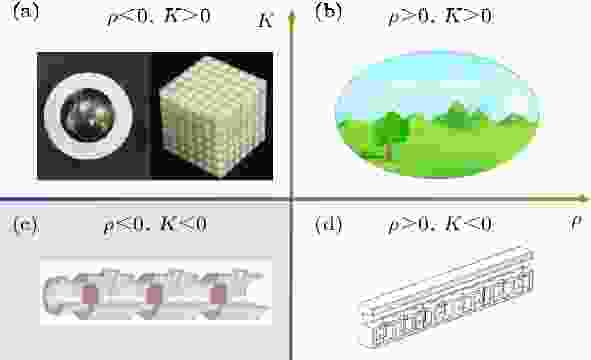
INVITED REVIEW
2019, 68 (19): 194301.
doi: 10.7498/aps.68.20190850
Abstract +
Acoustic metamaterials have opened up unprecedented possibilities for wave manipulation, and can be utilized to realize many novel and fascinating physical phenomena, such as acoustic self-collimation, cloaking, asymmetric transmission, and negative refraction. In this review, we explore the fundamental physics of acoustic metamaterials and introduce several exciting developments, including the realization of unconventional effective parameters, acoustic metasurface, total sound absorption, high-resolution imaging, parity-time-symmetric materials, and topological acoustics. Acoustic metamatetials with negative effective parameters that are not observed in nature expand acoustic properties of natural materials. Acoustic metasurfaces can exhibit wavefront-shaping capabilities, with thickness being much smaller than the wavelength. The precisely designed matematerials provide the new possibility of steering waves on a subwavelength scale, which can be used for acoustic high-resolution imaging beyond the diffraction limit. The metamaterial absorbers can achieve total sound absorption at low frequencies and exhibit broadband absorption spectrum. Moreover, structure designs guided by the topological physics further broaden the whole field of acoustic metamaterials. Phononic crystals have become aflexible platform for studying new physics and exotic phenomenarelated to topological phases. Finally, we conclude the developments of acoustic metamaterials, discuss the technical challenges, and introduce potential applications in this emerging field.
GENERAL

2019, 68 (19): 190201.
doi: 10.7498/aps.68.20190806
Abstract +
With the advent of global warming and energy crisis, the search for renewable energy to reduce carbon emissions has become one of the most urgent challenges. Ithas become a research hotspot to collect or harvest various mechanical energy in nature and convert it into electric energy. Vibration is a common form of mechanical movement in our daily life. It is visible both on most working machines and in nature and is a type of potential energy. There are several methods that can convert such mechanical energy into electric energy. Triboelectric nanogenerator (TENG) based on the principle of contact electrification and electrostatic induction which first appeared in 2012 by Zhonglin Wang provides a feasible method of efficiently collecting the vibrational energy with different vibrating frequencies. In this paper, a contact-separation mode of TENG is designed and implemented. The voltage- quantity of charge- distance(V-Q-x)relation of TENG is calculated. During the experiment, the factors such as load resistance, vibration frequency, etc. which affect the output performance, are considered and analyzed. An electrically driven crank-connecting rod mechanism is employed to provide the vibration source with adjustable frequency in a range of 1-6 Hz. The result shows that the amount of charge transfer in each working cycle remains almost unchanged, while the voltage and current increase with frequency increasing. When the frequency is 5 Hz, the best power matching resistance of the TENG is about 33 MΩ and the maximum output power reaches 0.5 mW. For a further study, a COMSOL software is used to simulate the distribution rule and variation rule of the electric potential in the contact-separation process, then the theoretical charge density and the experimental charge density on the polymer surface are compared and analyzed in order to provide theoretical and practical support for the design of TENG with collected vibration energy and self-powered vibration sensor. The result shows that the electric potential is proportional to the distance between two friction layers. While as the distance between two friction layers increases, the electric potential and the charge density both show a tendency to concentrate in the middle of the friction layer. The huge difference between experimental result and the simulation predicts thatmuch work should be done continually to improve the output of the TENG. Finally, the obtained results conduce to understanding the contact electrification and electrostatic induction mechanism and also provide a new method of harvesting the vibration energy.
2019, 68 (19): 190401.
doi: 10.7498/aps.68.20190437
Abstract +
In this paper, the modified Hawking radiation for Dirac particles via tunneling from the apparent horizon of Vaidya black hole is studied by using the Lorentz-violating Dirac field theory. We first extend the gamma matric from flat spacetime to the curved spacetime in the Lorentz-violating Dirac field theory, and generalize the general derivative to the covariant derivative. Then, by considering the commutative relation of the gamma matric, the Dirac equation in the Lorentz-violating Dirac field theory is obtained, which contains three correction terms related to the Lorentz-symmetry violation. In the semiclassical approximation, the modified Hamilton-Jacobi equation is obtained by using the commutative relation of gamma matric and treating the aether-like vector in the Lorentz-violating theory as a constant. We find that the modified Hamilton-Jacobi equation contains only two correction terms based on the Lorentz-symmetry violation, i.e. the corrected term containing the parameter a affects the mass term of the Dirac field, and the aether-like term containing the parameter c modifies the coefficient term of the action S of the separating variable. According to the modified Hamilton-Jacobi equation, we study the effect of Lorentz-symmetry violation on the characteristics of Hawking radiation for Dirac particles via tunneling from the apparent horizon ra = 2M(v) of Vaidya black hole (the apparent horizon of Vaidya black hole coincides with the timelike limit surface, so the apparent horizon can be regarded as the boundary of Vaidya black hole). Since the Hawking tunneling radiation of black holes is the radial property at the horizon of black holes, we finally find that only the aether-like term containing the parameter c can modify the characteristics of Dirac particles’ tunneling radiation from the black hole. In addition, the corrected Hawking temperature of the black hole caused by considering the effect on the Lorentz-violating Dirac field theory has a small correction related to the aether-like term, which is consistent with the results obtained by studying the characteristics of Hawking tunneling radiation for scalar particles in the Lorentz-violating scalar field theory. The results suggest that the Lorentz-symmetry violation theory may provide a new method to further study the information loss paradox of black holes.
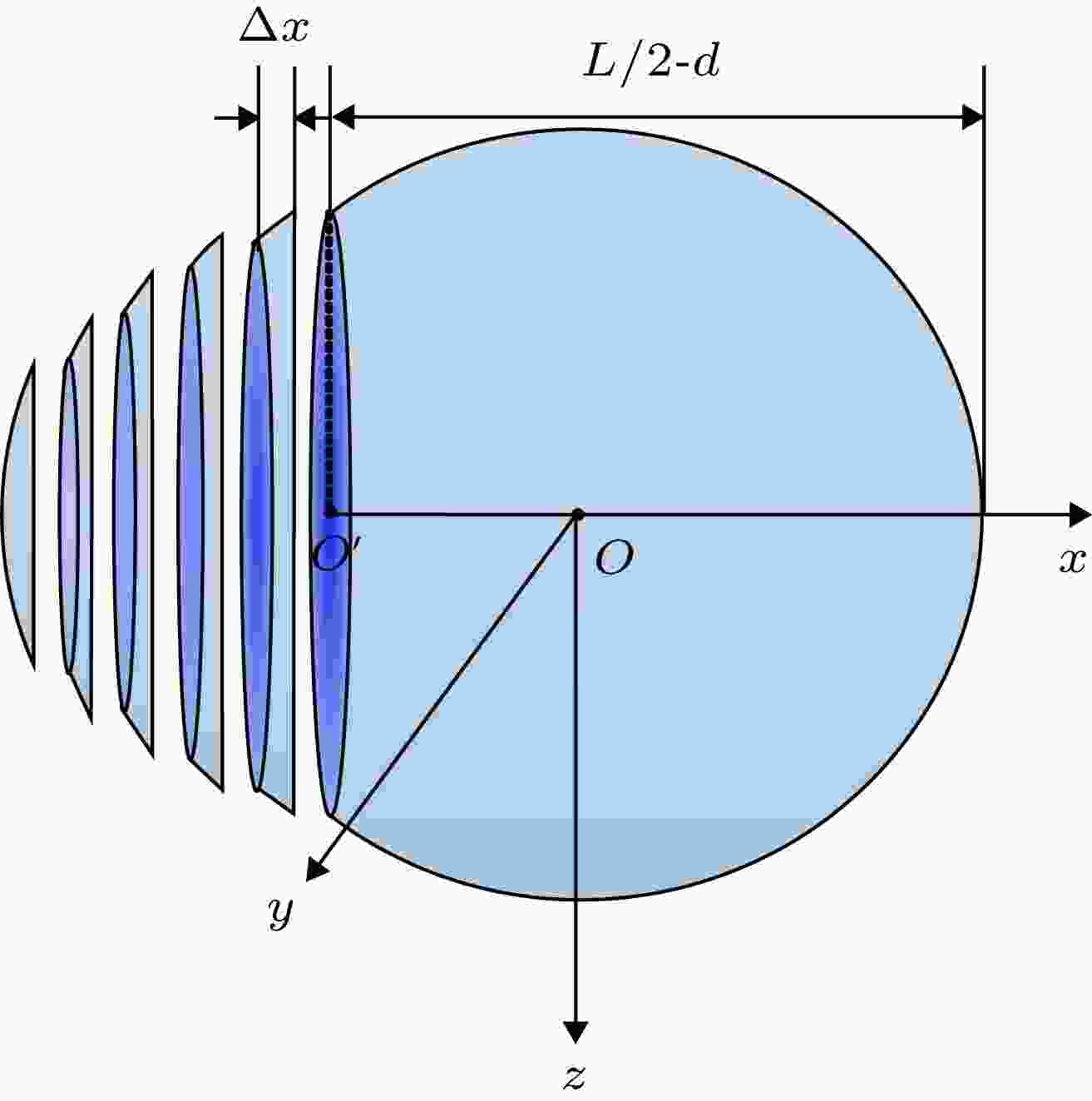
2019, 68 (19): 190601.
doi: 10.7498/aps.68.20190115
Abstract +
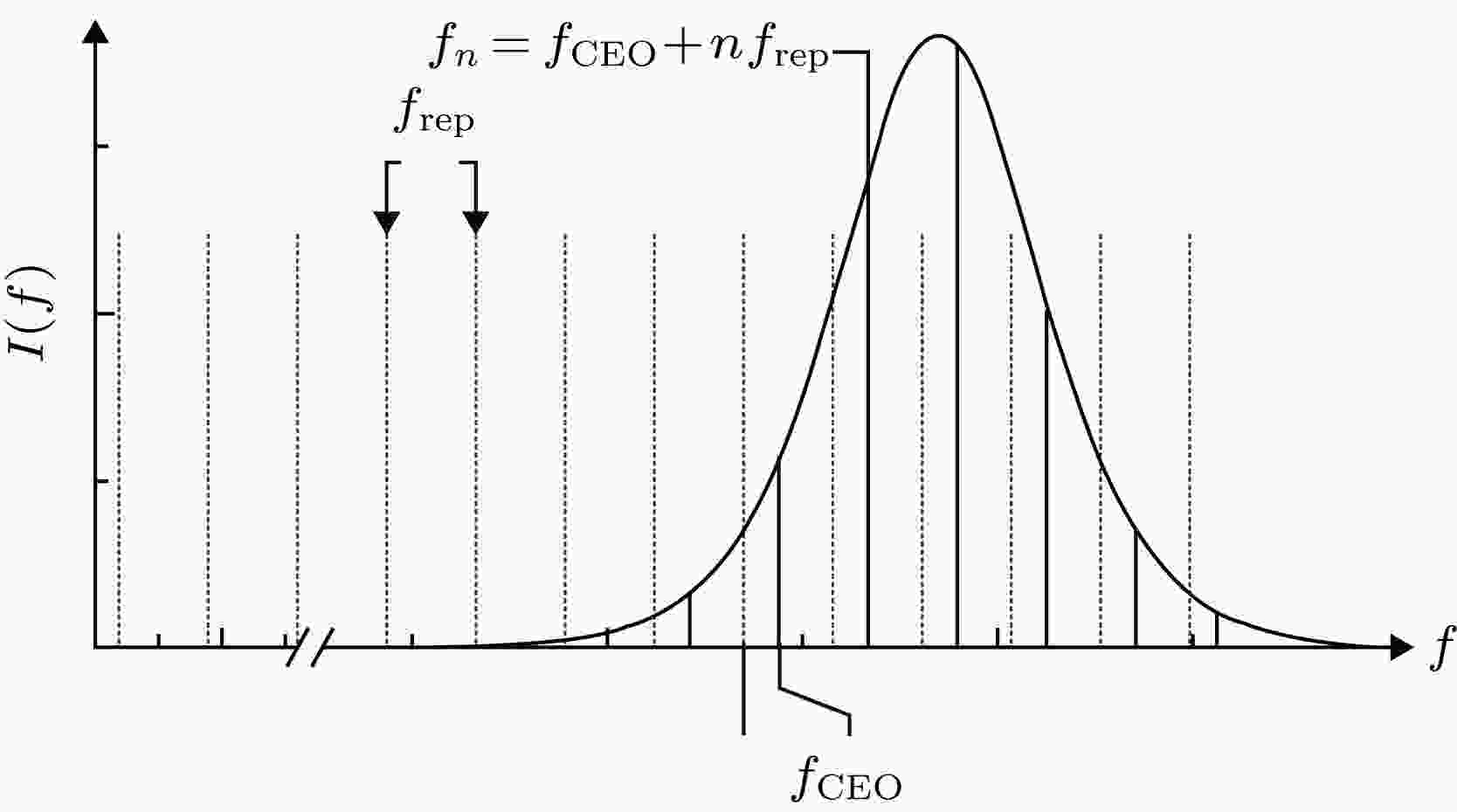
2019, 68 (19): 190602.
doi: 10.7498/aps.68.20190836
Abstract +

2019, 68 (19): 190701.
doi: 10.7498/aps.68.20190582
Abstract +
Segmentation of right ventricle (RV) in a cine cardiac magnetic resonance (CMR) image is essential for the diagnosis and therapy of cardiac diseases. Traditional image segmentation methods fail to achieve high accuracy due to the complex structure of RV. Multi-atlas frame, which transforms the segmentation into registration and fusion, has become one of the main segmentation methods of RV in recent years. In this paper, we suggest a new multi-atlas frame for the automatical and accurate segmentation of RV. Firstly, an adaptive affinity propagation algorithm is used to obtain a series of atlases, in which the atlas set most similar to the target image based on hausdorff distance and normalized mutual information is selected. Then, the target image is registered onto the selected atlas by using multi-resolution strategy-based affine transform and Diffeomorphic demons algorithm to generate a deformation field, which is applied to the label image to obtain coarse segmentation results of RV. Finally, the Consensus Level, Labeler Accuracy and Truth Estimation (COLLATE) algorithm is used to fuse the coarse segmentation result to obtain the RV. The 30 cine CMR datasets are applied to the retrospective analysis. The comparison between RV value from the present algorithm and that from the manual segmentation shows that the average dice index and hausdorff distance are 0.84 and 11.46 mm, respectively, the correlation coefficients and deviation means of endo-diastolic volume, endo-systolic volume and ejection fraction are 0.94, 0.90, 0.86, and 2.5113, –3.4783, 0.0341, respectively. Compared with convolutional neural networks, the new multi-atlas frame has an endo-systolic volume close to the manual result. The results show that the suggested method improves the accuracy and robustness of segmentation of RV from the effective atlas selection and multi-resolution Diffeomorphic demons algorithm-based registration, and it promises to be applied to clinical diagnosis.
ELECTROMAGNETISM, OPTICS, ACOUSTICS, HEAT TRANSFER, CLASSICAL MECHANICS, AND FLUID DYNAMICS

Discriminative sparsity graph embedding based on histogram of rotated princial orientation gradients
2019, 68 (19): 194202.
doi: 10.7498/aps.68.20190224
Abstract +
The unconstrained face images collected in the real environments include many complicated and changeable interference factors, and sparsity preserving projections (SPP) cannot well obtain the low-dimensional intrinsic structure embedded in the high-dimensional samples, which is important for subsequent sparse representation classifier (SRC). To deal with this problem, in this paper we propose a new method named discriminative sparsity graph embedding based on histogram of rotated principal orientation gradients (DSGE-HRPOG). Firstly, it extracts multi-scale and multi-directional gradient features of unconstrained face images by HRPOG feature descriptor and incorporates them into a discriminative feature dictionary of sparse representation classifier. Secondly, it seeks an optimal subspace of HRPOG feature dictionary in which the atoms in intra-classes are as compact as possible, while the atoms in inter-classes are as separable as possible by adopting the proposed DSGE dimensionality reduction method. Finally, an optimal algorithm is presented in which the low-dimensional projection and the sparse graph construction are iteratively updated, and the accuracy of unconstrained face recognition is further improved. Extensive experimental results on AR, Extended Yale B, LFW and PubFig databases demonstrate the effectiveness of our proposed method.

2019, 68 (19): 194101.
doi: 10.7498/aps.68.20182155
Abstract +

2019, 68 (19): 194201.
doi: 10.7498/aps.68.20190784
Abstract +
In order to solve the technical problem of the traditional electric field sensor limited by its measurement range, a parity-time (PT) symmetric microcavity structure doped by electro-optical medium is designed, and a new electric field sensing mechanism is proposed. The transfer matrix method is used to calculate the transmission spectrum of the structure. A unique amplified defect mode is found. The peak value and wavelength position of the defect mode vary with the external electric field. The same electric field can be measured by using two mechanisms. One is to detect the change of the defect mode peak value, and the other is to measure the change of the defect mode wavelength position. The measurement range is limited only by the breakdown field value of the electro-optical medium, which can range from 0 to 0.06 V/nm, covering almost any possible electric field environment. For the peak-value sensing mechanism, the sensitivity range is 38.042—47.558 (nm/V); for the wavelength position sensing mechanism, the sensitivity range is 18.357—18.642 (nm2/V), and the average resolution in the measurement range is 0.00925 V/nm.

2019, 68 (19): 194203.
doi: 10.7498/aps.68.20190427
Abstract +
The vertical-cavity surface-emitting laser (VCSEL) is usually used as an 850nm short wavelength source for short-distance optical interconnection at normal temperature. In this study, the characterization of the VCSEL at low temperature was mainly studied. The laser spectra and the P-I-V curves are obtained with direct current and pulse current with 10% duty-cycle at different temperatures. It indicates that the VCSEL can work at 10K temperature environment. When the VCSEL laser is driven by direct current in a temperature range from 295 K to 10 K, the central wavelength of the laser is first red-shifted and then blue-shifted due to the change of environmental temperature and thermal effect on the device. With a pulsed-current driven source, the smaller the duty cycle, the less the heat generated by the device will be. The laser spectrum shows a blue-shift trend in the cooling process. The spectral width remains approximately stable in the cooling process. With temperature decreasing, the laser threshold current increases, and the lower the temperature, the larger the threshold current will be. It shows that the cavity mode and the gain spectrum shift with temperature changing. The cavity mode and the gain spectrum both shift to red with temperature increasing, and they shift to blue with temperature decreasing. But their shifting speeds are different. The mismatch between the cavity mode and the gain curve causes the device to need more energy for lasing. So the laser will work at a higher current driven at low temperature. The laser can work at low temperature as a stable light source. Therefore, the VCSEL has potential applications in optical interconnection system as a source at low temperature.
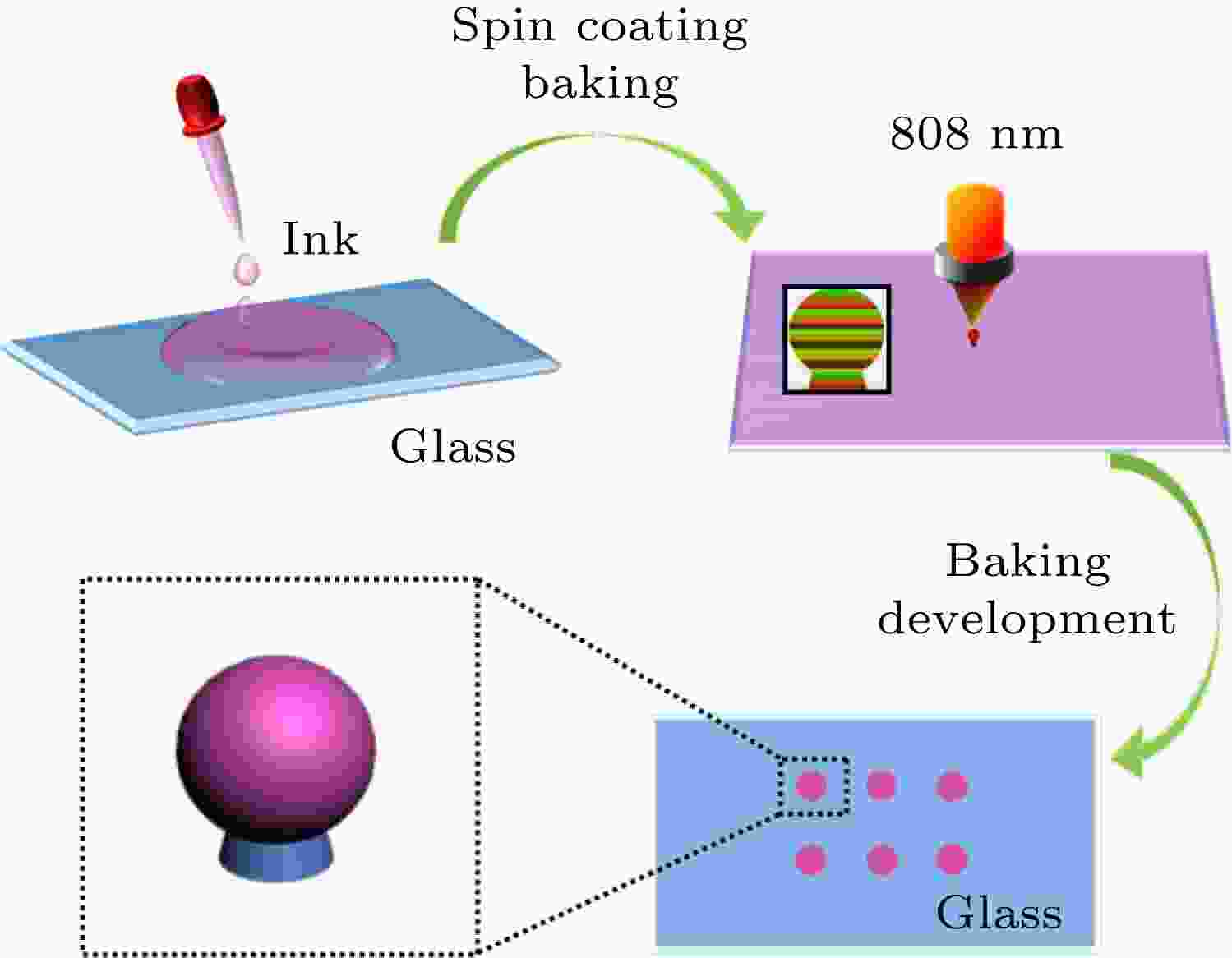
2019, 68 (19): 194204.
doi: 10.7498/aps.68.20190298
Abstract +
The whispering gallery mode (WGM) microcavity has been widely used for sensing and detection because of its high quality factor, small mode size, simple and diverse manufacturing process, and high sensitivity to the surrounding environment. Microsphere cavityand microdisk cavity are typical whispering gallery mode microcavities. However, the real controllable size of the on-chip three-dimensional microsphere cavity has rarely been reported because it is difficult to prepare by photolithography. At the same time, most of the current microsphere cavity are prepared by hot melting, which have the poor ability to control the size. In this article, we have mainly demonstrated the fabrication of a dye-doped polymer whispering gallery mode microsphere by femtosecond laser two-photon polymerization, which shows good surface smoothness with a fabrication spatial resolution beyond the diffraction limit. The microsphere cavity consists with commercial photoresist SU-8 as the cavity material and Rhodamine B as the gain medium. With the 532 nm pump, the RhB-doped SU-8 can emit fluorescence in the spectral range of 600–700 nm, and thus resonant whispering gallery laser modes in this spectral region can be eventually formed in the microsphere cavities. The microcavity shows excellent lasing performance with a quality factor of ~2000. Due to the special luminescence mechanism of organic dyes, the fluorescence spectrum of the dye drifts with the change of ambient temperature, and it will form a new resonance excitation with the eigenmode of the cavity. Within a certain temperature range (20 ℃-35 ℃), the wavelength of the main lasing peak is linearly related to temperature. The results shows that the organic dye doped micro-resonator has a unique laser mechanism which can be used to construct a new type of microlaser. Moreover, the tunable microsphere laser can be used as a temperature sensor after further optimized. We believe our work will provide a positive inspiration for the rational design of miniaturized lasers with ideal performance.
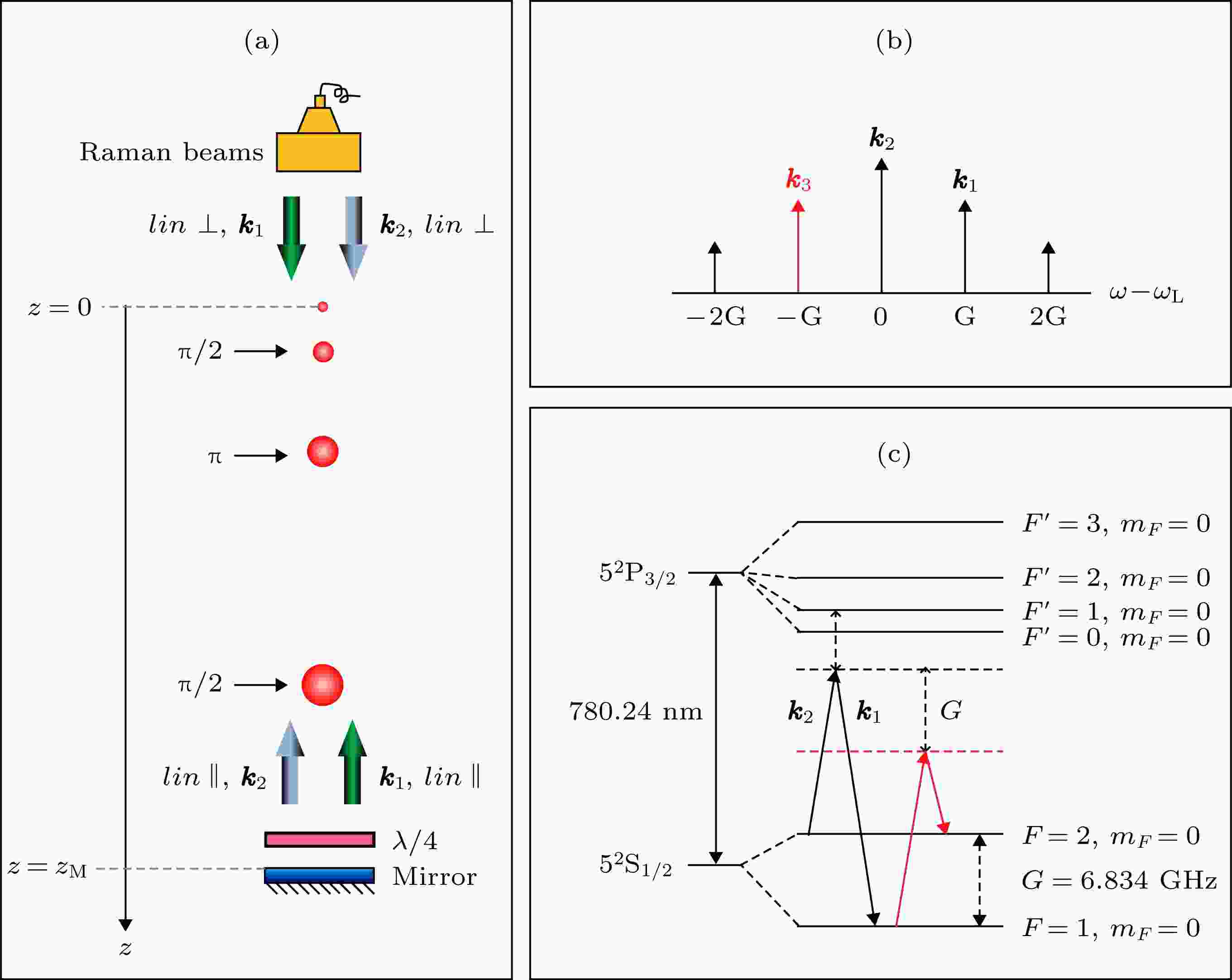
2019, 68 (19): 194205.
doi: 10.7498/aps.68.20190581
Abstract +
The technology of electro-optic modulation is one of the several methods of generating the Raman beams. The experimental system based on this method is simple and much easier to implement, and the environmental adaptability is strong as well. However, this kind of modulation technology will produce additional laser lines, which may affect the measurement accuracy of cold atom gravimeter. Based on a homemade transportable cold atom gravimeter, the influence of Raman sideband effect on the accuracy of cold atom gravimeter is investigated in this paper. We analyze in detail the relationship between Raman sideband effect and some experimental parameters, such as the height of Raman retro-reflection mirror, the time of free fall of the atoms, the detuning of Raman laser, etc. It is found that those parameters have a dominant influence on the measured gravity resulting from Raman sideband effect. Besides, it is also found that the gravity measurements will be sensitive again to some experimental parameters in the case of Raman sideband effect while these parameters are usually insensitive in case of laser system without sideband effect. Finally, we investigate the relationship between Raman sideband effect and Raman detuning, and presente a method of evaluating the gravity induced by Raman sideband effect. The experimental results in this paper can provide a reference for reducing the influence of Raman sideband effect on the accuracy evaluation of cold atomic gravimeter.

2019, 68 (19): 194206.
doi: 10.7498/aps.68.20190321
Abstract +
Femtosecond streak camera is currently the only diagnostic device with a femtosecond time resolution. Scanning circuit with bilateral symmetrical output is an important part of femtosecond streak camera. To achieve better performance of the streak camera, high requirements are placed on the output of scanning circuit. Owing to the excellent feature of litter time jitter and fast response speed, a GaAs photoconductive semiconductor switch (PCSS) has become a core device in the scanning circuit. Investigating the positive and negative symmetric pulses with fast rising edgeof GaAs PCSS is of great significance to improving the time resolution of femtosecond streak camera. In this paper, a laser with a pulse width of 60 fs was used to trigger a GaAs PCSS with an electrode gap of 3.5 mm. Under different storage capacitors and bias voltages, the positive and negative symmetric pulses withthe fastest rise time of 149 ps and the highest voltage transmission efficiency of 92.9% were obtained. The test results meet the design requirements of streak camera to realize femtosecond time resolution. Through the comparative analysis of the experimental values, it is concluded that the storage capacitor can affect the efficiency and rise time of the output electrical pulse in the same trigger laser pulse. By calculating the multiplication rate of carriers in combination with the output electrical pulse waveform, it is concluded that the GaAs PCSS operates in linear mode. According to the working characteristics of the linear mode and the energy storage characteristics of the capacitor, the analysis indicates that, when the characteristics of the trigger laser pulse are the same, the transmission efficiency and rise time of the output electric pulse voltage increase with the increase in storage capacitor, which is consistent with the experimental results. This study has a certain guiding significance for the better application of GaAs PCSS in femtosecond streak camera, which also has a certain propelling effect on improving the time resolution of femtosecond streak camera.

2019, 68 (19): 194207.
doi: 10.7498/aps.68.20190430
Abstract +
During recent years, the filamentation of femtosecond laser in the atmosphere has contributed considerable interest to researchers. However, the actual atmosphere can result in different scattering medium, which are adverse to the application of filamentation in the atmosphere. In order to study the propagation of femtosecond laser in real scattering medium, the propagation of 800 nm femtosecond laser in ice cloud, water cloud, fog, aerosol and rainfall is simulated numerically. Combined with the theory of stratified medium model and Mie scattering theory, we constructed a scattering model with a changeable size distribution function in the nonlinear laser model. The results indicated that the different size distribution and phase state of particles have different influence on the propagation properties of the filaments. As the rainfall was dominated by large raindrops, the scattering on filament was the strongest, resulting in the lowest peak intensity and energy. In the case, the distribution of filament energy was extremely inhomogeneous, causing the shortest length of filament and generation of multi-filament. In the image of fluence distribution, a diffraction ring can be observed clearly in the rainfall but was blurred in other medium. The propagation properties of filaments in water cloud and fog were similar because of the same size distribution. However, due to the size of particle in fog was smaller than that in water cloud, the filaments had more higher energy and more concentrated distribution in fog. In addition, the scattering of ice particles was stronger than that of liquid droplets, so the energy of filament in ice cloud was lower than that in water cloud, resulting a reducing of the length and number of filaments in ice cloud. The size of aerosols was the smallest, which had the weakest influence on the filament. Accordingly, in the early of propagation, there had little perturbance on the filament and the beam was transmitting with a stable single filament, and results in the highest peak intensity and energy. With the propagation increasing, the accumulation of scattering attenuation produced the perturbation on filament at a position after the onset of filamentation.
ATOMIC AND MOLECULAR PHYSICS

2019, 68 (19): 193101.
doi: 10.7498/aps.68.20190995
Abstract +
Single-atom catalysts play a crucial role in repairing defective graphene, but the existing research on the single-atom catalysts focuses on the reduction of energy barriers. The unique repairing behavior of the single-atom catalysts in the graphene-healing process and the different repair mechanisms between different catalyst atoms have not been studied in depth. In this paper, the molecular dynamics simulation is used to study the the self-repairing process of defective graphene in the presence of Ni and Pt atoms. By changing the system temperature, multiple sets of simulations are obtained. By observing the atomistic structure obtained at the end of the simulations, the different catalytic repair effects are studied. We calculate the variation of 5, 6 and 7-member rings of graphene in the repair process, it is found that at the appropriate temperatures (1600 K and 2000 K), Ni atom shows stronger catalytic repair capability than Pt atom, and as the temperature increases, the repair effect on defects is also improved. By comparing with the repair process without metal atoms, we find that the effect of metal atoms is significant especially in repairing the carbon chain. To figure out the reason, some typical structure evolutions are simulated. The simulations show that when Ni atom can capture carbon chains at 1600 K, Pt atom needs higher temperature at least 2000 K. Apart from that, Ni and Pt atoms respectively lead to local structural transformations of " jump from the ring” and " bond breakage”. This may be the reason why the 5, 6, and 7-membered rings in the final structure of Pt catalytic system are less than those of Ni catalytic system at 1600 K and 2000 K. In addition, we map the migration route of metal atoms and calculate the migration distance. By observing the different migration behaviors of the two metal atoms in and out of the plane, the different catalytic mechanisms are further studied. The research results in this paper conduce to understanding the catalytic mechanism of metal atoms in the repair of defective graphene. It is of theoretical significance for selecting the external conditions and catalysts for the repairing of defective graphene.

2019, 68 (19): 193701.
doi: 10.7498/aps.68.20190347
Abstract +
Optomechanical cavity is a powerful connection between a nanomechanical oscillator and a quantized electromagnetic field. In this system, a novel photon-phonon nonlinear interaction arising from the nanomechanical oscillation is produced through the radiation pressure. Now this nonlinear photon-phonon interaction has become an important resource for implementing high-precision measurements and processing quantum information. Motivated by T. Esslinger group’s experiment, it is very meaningful to explore the exotic quantum phenomena when a ultra-cold BEC is trapped in an optomechanical cavity. In this paper, we mainly investigate phase transition and the finite-temperature thermodynamic properties of a Bose-Einstein condensate in an optomechanical cavity. It’s worth mentioning that at zero temperature many different mean-field approximate methods have been used to analyze the ground state properties of a Bose-Einstein condensate in an optomechanical cavity. Two common methods are Holstein-Primakoff transformation and spin coherent state variation. In this paper, an interesting imaginary-time path integral approach has been introduced to study finite temperature thermodynamic properties and phase transition of a Bose-Einstein condensate in an optomechanical cavity. First, we obtained system's partition function by taking imaginary-time path integration. Meanwhile, an effective action has been obtained by means of this method, which is the basic of the variation to get the numerical solution of photon number and the expression of the atomic number. At zero temperature, these results are consistent with what we have obtained by Holstein-Primakoff transformation or spin coherent state variational method. By adjusting the atom-field coupling strength and other parameters the second-order phase transition from the normal phase to the superradiant phase has been revealed. Meanwhile, a new unstable superradiant state was also found. And we found that in addition to the normal phase and superradiation phase, there exists an un-solution region of the mean photon number. Meanwhile, we find that the nonlinear photon-phonon interaction does not affect the normal phase. However, in the superradiant phase, the nonlinear photon-phonon interaction can enhance the macroscopic collective excitations. At the same time, the thermodynamic properties of the system are also discussed. According to the obtained distribution function, we can derive the analytical expression of the average energy and the free energy. Furthermore, the expression of entropy at finite temperature can also be obtained. we find the nonlinear photon-phonon interaction does not affect the average energy in the normal phase, but the average energy in the superradiant phase can deeply deviate in the large nonlinear photon-phonon interaction. It’s worth mentioning that the mean photon number and average energy in the finite-temperature tend to be consistent with the case in absolute zero temperature in the strong coupling region, while the entropy in the superradiant phase is rapidly reduced to zero as the atom-field coupling strength increases. In other words, strongly coupled collective excited states are highly ordered and are not affected by thermal fluctuations in the temperature range we are considering. The thermodynamic properties, such as the entropy and corresponding specific heat, characterize the Dicke phase transition.
PHYSICS OF GASES, PLASMAS, AND ELECTRIC DISCHARGES
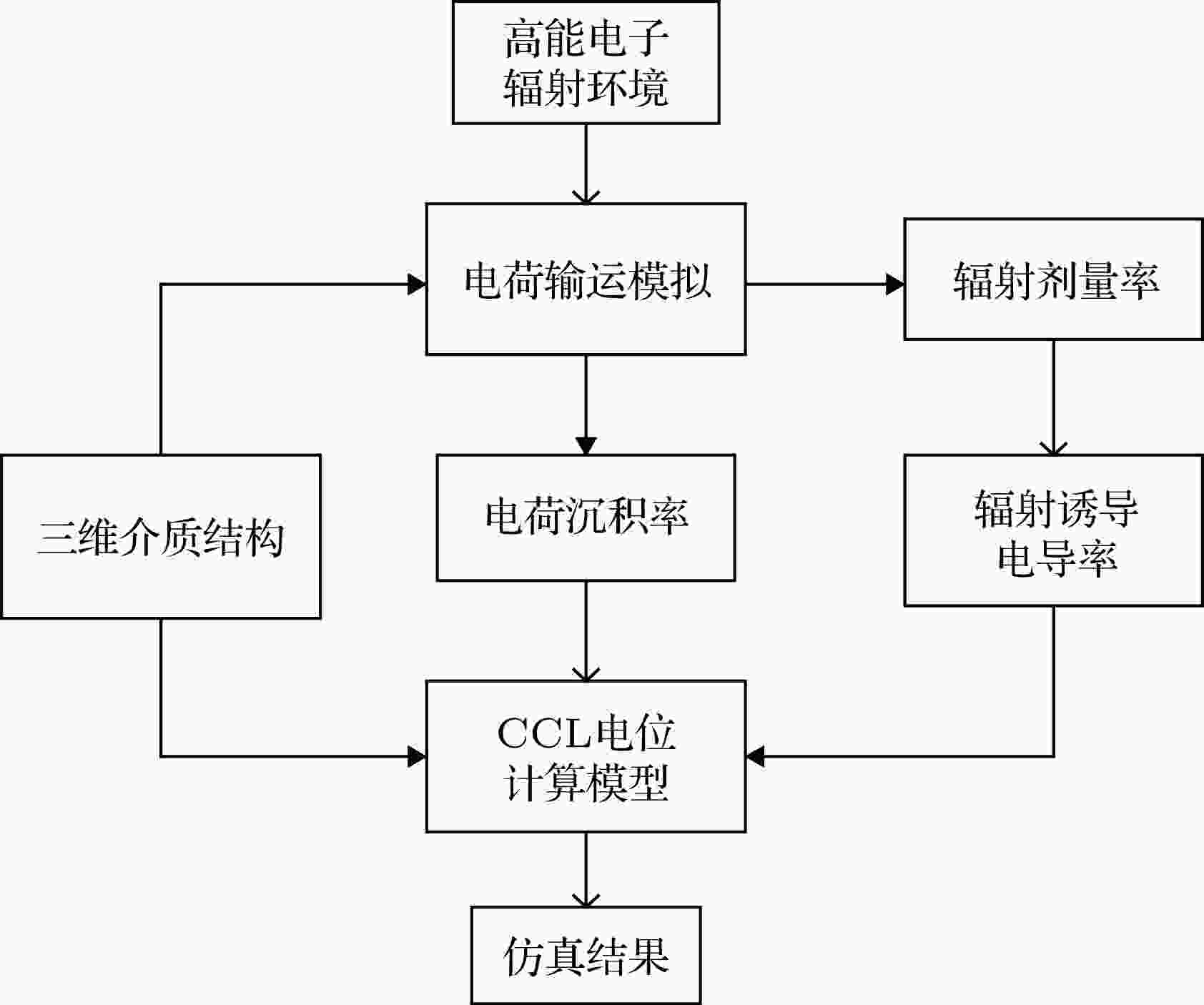
2019, 68 (19): 195201.
doi: 10.7498/aps.68.20190631
Abstract +
The simulation is one of the important methods to evaluate the internal charging risk in spacecraft. In this paper, based on the charge conservation law, a three-dimensional calculation model of the potential and electric field of internal charging is established, and the one-dimensional steady state and transient solution algorithm and the two-dimensional and three-dimensional solution scheme of the model are given. An interative algorithm is designed to solve the required conductivity and the electric field intensity, and the convergence of the interative algorithm is analyzed. Using the finite element algorithm and the local mesh refinement, the model has the advantage of easily investigating the electric field distortion at key points. Comparing with the existing radiation-induced conductivity (RIC) model, due to the fact that the internal charging time constant is much higher than the charge capture time and the trap density in the dielectric is much higher than the charge density after the charge balance, the free charge will be rapidly converted into the captured charge. Therefore, it is unnecessary to consider the charge capture mechanism in the RIC model. The CCL model can be used to evaluate the internal charging and has higher computational efficiency. Comparing with the experimental data, the correctness of the three-dimensional calculation model is verified. It provides a means to evaluate the dielectric internal charging in spacecraft.

2019, 68 (19): 195202.
doi: 10.7498/aps.68.20190883
Abstract +
Based on particle-in-cell simulations, the propagation of intense long pulse lasers in non-uniform plasma, and particularly, the formation of plasma density cavities caused by the nonlinear evolution of stimulated Raman scattering (SRS) near the quarter critical density, and its effects on parametric instabilities have been studied. It is found that the stimulated Raman scattering instability developed near the quarter critical density leads to the trapping of scattered light and subsequent formation of a local electromagnetic solitary wave. Its amplitude increases with the development of the SRS instability, which pushes surrounding electrons and ions to form a quasi-neutral density cavity. When the first density cavity is formed, the plasma density evolves in such a way that more density cavities are formed during the laser interaction and subsequently the plasma is split into a few discontinuous portions. This new density profile finally tends to suppress the development of both SRS and the stimulated Brillouin scattering (SBS) instabilities considerably.
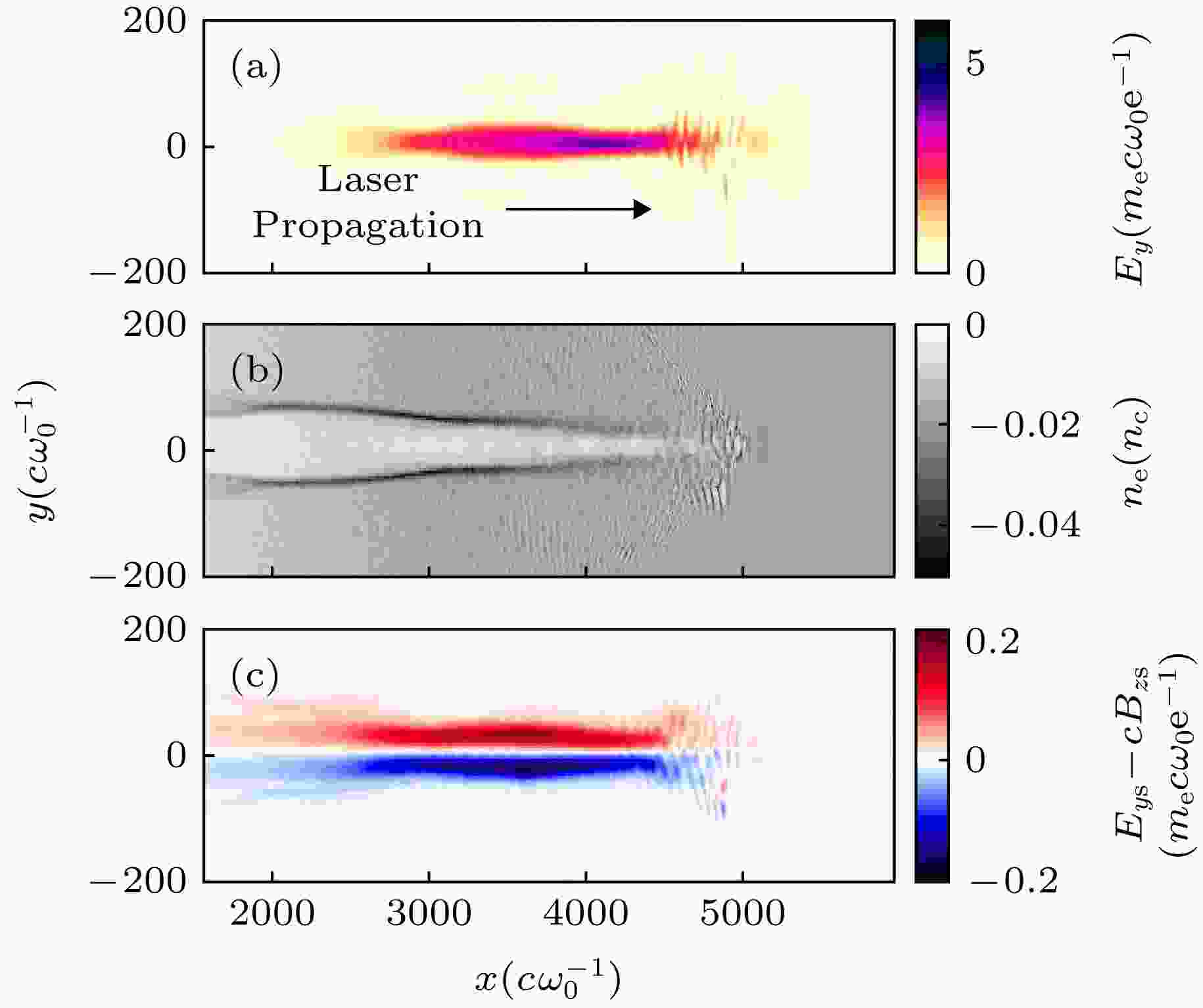
EDITOR'S SUGGESTION
2019, 68 (19): 195203.
doi: 10.7498/aps.68.20191106
Abstract +
Energetic electron beam can be generated through the directlaser acceleration (DLA) mechanism when high power picosecond laser propagates in underdense plasma, and the electron yield can reach several hundred nC, which has a great application in driving secondary radiations, such as bremsstrahlung radiation and betatron radiation. When a linearly polarized laser is used, the beam divergence is always larger in the laser polarization direction. What is more, the forked spectral-spatial distribution is observed in the experiments driven by femtosecond laser where DLA is combined with the laser wakefield acceleration (LWFA). The forked distribution is regarded as an important feature of DLA. However, an analytical explanation for both the bigger divergence and the forked spectral-spatial distribution is still lacking. Two-dimensional (2D) particle-in-cell simulations of picosecond laser propagating in underdense plasma are conducted in this paper to show how the fork is formed in DLA. The fork structure is a reflection of the distribution of electron transverse velocity. We find that when electrons are accelerated longitudinally, the transverse oscillation energy in the laser polarization direction increases correspondingly. If the electron energy is high enough, the transverse oscillation energy will increase linearly with the electron energy. As a result, the most energetic electrons will have an equal amplitude of vy, where vy denotes the velocity in the laser polarization direction. For a single electron, the distribution of its transverse velocity over a long period $\dfrac{{{\rm d}P}}{{{\rm d}{v_y}}}$ , will peak at ±vm (vm denotes the amplitude of vy). If all the electrons have the same vm, the distribution of vy at a given time will be the same as $\dfrac{{{\rm d}P}}{{{\rm d}{v_y}}}$ . That means they will split transversely, leading to a forked spectral-spatial distribution. By using a simplified model, the analytical expression of vm is derived, showing good agreement with vm in the PIC simulation. However, the oscillation energy in the direction perpendicular to polarization will decrease when electrons are accelerated longitudinally (acceleration damping). As a consequence, the divergence perpendicular to the polarization direction will be smaller. Our research gives a quantitative explanation for the transverse distribution of electrons generated by DLA. With some modification, it can also be used in DLA combined LWFA to better control the dephasing length.

2019, 68 (19): 195204.
doi: 10.7498/aps.68.20190583
Abstract +
High-power impulse magnetron sputtering (HiPIMS) is a new magnetron sputtering technique which can produce high-density plasmas with a high ionization rate and prepare coatings with a good performance such as large density and high adhesion. To obtain stable discharge and universal materials’ ionization rates, a cylindrical cathode is proposed based on the hollow cathode effect. However, the unusual plasma transport results in a large loss of ions and a low deposition rate. To solve these problems, an expanding electromagnetic field is proposed to control the plasma transport in this work. The particle in cell/Monte Carlo collision (PIC/MCC) method and the plasma diffusion model are used to simulate the plasma transport in and out of the cylindrical cathode with different currents in the electromagnetic coils, respectively. The simulation results reveal that different electromagnetic fields can achieve different plasma density distributions, resulting in different accumulated positions and different diffusion paths. When the coil current is positive, the resistance to axial motion of electrons is small but the resistance to radial motion is large, so that the hollow cathode effect is weakened and the plasma beam tends to output uniformly. When the coil current is negative, the resistance to axial motion of electrons is large but the resistance to radial motion is small, so that the hollow cathode effect is enhanced and the plasma tends to gather on the central axis and then diffuses outward. To verify the simulation results, Ar/Cr HiPIMS discharge experiments are carried out with the cylindrical cathode in a homemade vacuum system. The experiment results indicate that the threshold voltage, the plasma flow shape, the optical emission spectrum (OES) intensity, and the deposition distribution are determined by the electromagnetic coil current. The variation tendency is in coincidence with the prediction of the simulation. Consequently, by adding an expanding electromagnetic field, the plasma discharge in the cylindrical cathode can be easily controlled and the deposition rate is greatly enhanced. This electromagnetic control strategy not only realizes the enhancement and effective control of plasma, but also improves the homogeneity and the deposition rate of the coatings, thus laying a foundation for the industrial application of HiPIMS.
CONDENSED MATTER: STRUCTURAL, MECHANICAL, AND THERMAL PROPERTIES

2019, 68 (19): 196101.
doi: 10.7498/aps.68.20190490
Abstract +
Improving the oxidation resistance of TiAl-based alloys at high temperature has great significance for expanding their application fields. Adding ternary and quaternary elements is one of the effective ways to solve the oxidation problem of this kind of alloys materials. The first-principles method based on density functional theory was used to study the Si and Y substitution co-doping effects on the oxidation resistance of γ-TiAl based alloys from the aspects of atomic average formation energy and elastic constant of system, as well as the formation energies of interstitial O atom, Ti vacancy and Al vacancy in the system. The results indicate that the atomic average formation energies of the Si and Y dual-doped systems are all negative, which imply they possess energy stability and can be prepared by experiments. In addition, the elastic constants of most Si and Y substitution co-doping γ-TiAl systems satisfy the mechanical stability criterion. For the mechanical stable systems, the analysis results about the formation energies of the interstitial O atom, Ti vacancy and Al vacancy reveal that the Ti6SiYAl8 series, in which both Si and Y substitute Ti, have obvious promotion effect on the improvement about oxidation resistance; system Ti7YAl7Si, in which Y substitutes Ti and Si substitutes Al, and system Ti7SiAl7Y, in which Si substitutes Ti and Y substitutes Al, have uncertain influence on improving oxidation resistance; system Ti8Al6SiY, in which both Si and Y substitute Al, is harmful to the improvement about oxidation resistance of the γ-TiAl based alloys. Therefore, the preparation conditions should be controlled moderately so that both Si and Y substitute Ti at the same time to form a large proportion configurations of Ti6SiYAl8 series in the materials. In these configurations, the outward diffusion of Ti atoms and the inward diffusion of interstitial O atoms are suppressed, meanwhile the outward diffusion of the Al atoms is facilitated. In this way, the production of α-Al2O3 is promoted and that of TiO2 is weakened on the surface of co-doping γ-TiAl based alloys. Thus, a scale rich in α-Al2O3, i. e., a continuous, dense, and protective oxide scale can be grown on the surface of Si and Y substitution co-doping γ-TiAl alloys.

2019, 68 (19): 196102.
doi: 10.7498/aps.68.20190593
Abstract +
Cu-Ni-Si alloy has good electrical conductivity, thermal conductivity, high strength, and high hardness, and is widely used in electronic components and other fields. When the compositions of the Cu-Ni-Si alloy are designed, the determination of the phase component is critical. In this work, the composition of Cu-Ni-Si alloy is designed according to the "precipitation phase" by cluster-plus-glum-atom model. Following the cluster selection criteria, the δ-Ni2Si, γ-Ni5Si2 and β-Ni3Si phase clusters are determined, respectively, and the corresponding cluster formulas are [Ni-Ni8Si5]Ni,[Si-Ni10]Si3, and [Si-Ni12]Si3. the compositions of a series of Cu-Ni-Si alloys are designed according to the different precipitated phases of δ-Ni2Si, γ-Ni5Si2, and β-Ni3Si each with Cu atom content being 93.75%, 95%, 95.8%, 96.7% and 97.5%, respectively. The alloy raw material is melted into alloy ingot in an argon-filled vacuum arc furnace. The ingots undergoes solid-solution at 950 ° C for 1 hour and water quenching then aging treatment at 450 ° C for 4 hour and water quenching. The conductivity and Vickers hardness of the alloy are tested by conductivity meter and hardness meter, respectively. The microstructure of the alloy is characterized by x-ray diffraction (XRD), scanning electron microscopy (SEM), and transmission electron microscopy (TEM). In general, the electrical conductivity of Cu-Ni-Si is the main consideration in the design of alloy composition, the content values of matrix Cu atoms are in the ranges of 90%-95.63% and 95.63%-97.5% respectively, the precipitated phases are designed according to δ-Ni2Si and γ-Ni5Si2 respectively; the content of matrix Cu atoms is over 97.5%, it can be designed according to any phase of δ-Ni2Si, γ-Ni5Si2 and β-Ni3Si, with no difference in electrical conductivity among them. If the strength of the alloy is the main factor in the composition design, the content values of Cu atoms in the matrix are in the ranges of 90% — 93.93%, 93.93% — 94.34%, 94.34%— 95.63%, and 95.63%—96.12% respectively, according to the composition intervals the precipitated phases are designed as δ-Ni2Si, γ-Ni5Si2, β-Ni3Si, and γ-Ni5Si2, respectively. Once the content of Cu in the matrix is greater than 96.12%, the precipitated phase can be designed according to any of the phases of δ-Ni2Si, γ-Ni5Si2 and β-Ni3Si.
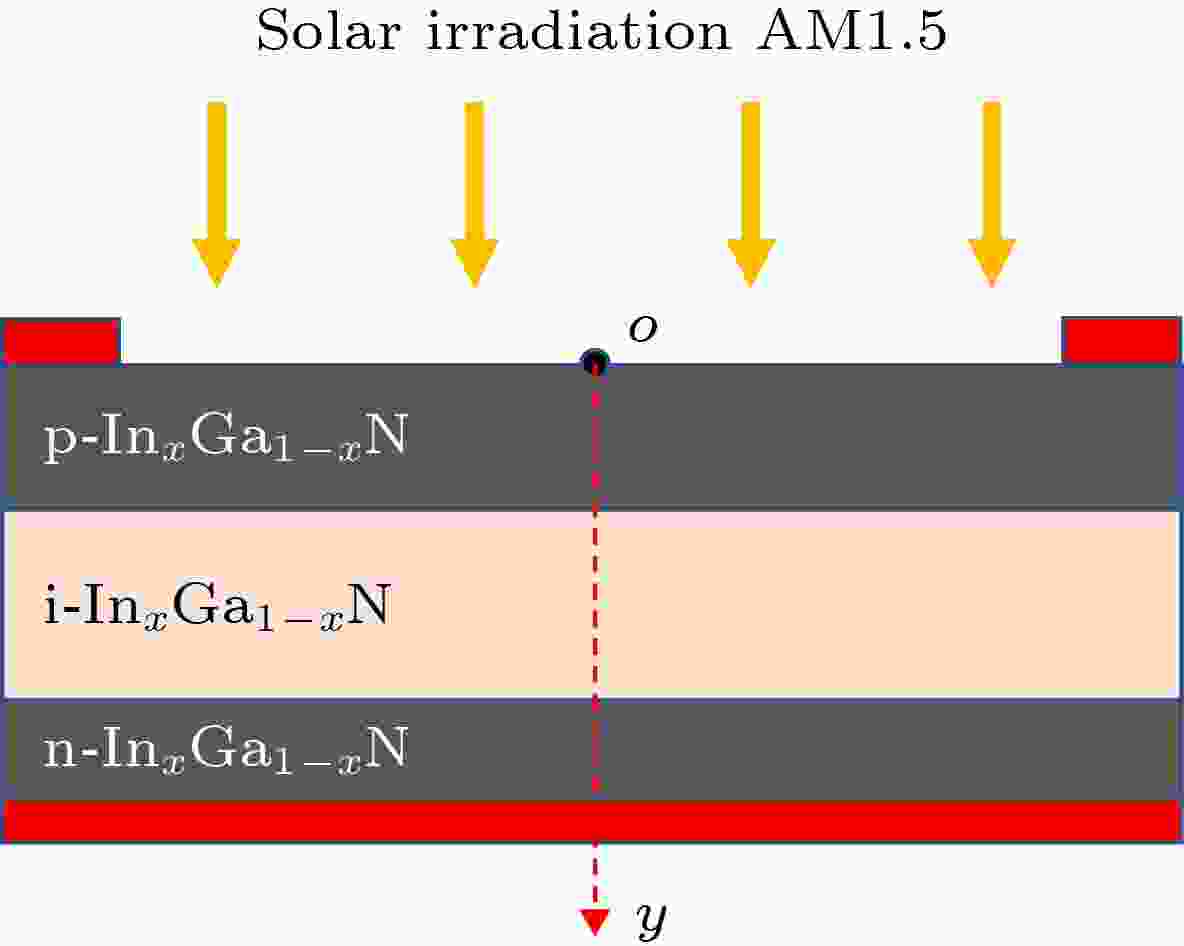
2019, 68 (19): 196103.
doi: 10.7498/aps.68.20191042
Abstract +
In this paper, the effects of p-layer hole concentration and p-layer thickness on the performances of InGaN p-i-n homojunction solar cells with different indium components and their intrinsic mechanisms are investigated by numerical simulations. it is found that the conversion efficiency of solar cells first increases and then decreases slightly with the increase of p-layer hole concentration and p-layer thickness. Moreover, the change of p-layer hole concentration and p-layer thickness will cause great changes of the conversion efficiency of the solar cells, especially as the indium composition increases. In order to better clarify and understand the physical mechanism of this phenomenon, the collection efficiency, I-V characteristic, built-in electric field and carrier transport of solar cells are analyzed in this paper. When the hole concentration is insufficient, the build-in electric filed is not strong enough to separate the most of the electric-hole pairs. This will reduce the collection efficiency. In addition, the lower the hole concentration, the higher the series resistance of solar cells will be and the more the power loss. So a conclusion can be drawn that the lower hole concentration of p-layer would be accompanied by the reduction of collection efficiency and the increase of series resistance, thus resulting in a lower conversion efficiency. With the increase of the hole concentration which is below an optimal value, the built-in electric field reaches the threshold, which can improve the collection efficiency. At the same time, although the series resistance is reduced to a certain extent, it still reduces the effective output power and limits the conversion efficiency. When the hole concentration is higher than the optimal value, the carrier mobility becomes the main factor limiting the conversion efficiency. As for the p-layer thickness, the simulation results indicate that the lateral transport of carriers from the p-layer to the anode electrodes becomes more obstructive with the thinning of p-layer thickness. This is because when the p-layer thickness decreases, thus causing the p-layer sectional area to decrease, the lateral series resistance becomes higher. It is clear that when the p-layer is too thin, the lateral series resistance is one of the main limiting factors affecting the conversion efficiency of solar cells.

EDITOR'S SUGGESTION
2019, 68 (19): 196401.
doi: 10.7498/aps.68.20190910
Abstract +

2019, 68 (19): 196402.
doi: 10.7498/aps.68.20190662
Abstract +
The K-shell has important theoretical significance and application value in measuring the importance of nodes in complex networks. However, in the K-shell method, most of nodes possess an identical K-shell value so that the relative importance of the identical K-shell nodes cannot be further compared with each other. Therefore, based on the K-shell value of nodes in the complex network and the K-shell values of multi-order neighbors in complex networks, in this paper we use the vectors to represent the relative importance of node in each of complex networks, which is named multi-order K-shell vector. Multi-order K-shell vector centrality defines a vector indicating the number of multi-order neighbors with different K-shells and groups them into elements of the vector. Each vector infers to not only the original K-shell of the given node but also the number of its multi-order neighbors and their K-shell values, which indicates the propagation capability of the given node. An approach to comparing two multi-order K-shell vectors is also presented, which is used to sort the vectors to evaluate the node importance. The method is explored by comparing several existing centrality methods. Through the experiments of SI propagation and static attack experiments in seven real-world networks, it is found that multi-order K-shell vector centrality provides low computational complexity, effectively evaluates nodes with high propagation capability, which confirms the improved performance in susceptible infected model propagation experiments. On the other hand, the static attack experiments show that the multi-order K-shell vector tends to preferentially select the core structure with powerful propagation capability in the network. The multi-order K-shell vector greatly improves the difference rate of node centrality under the premise of preserving the K-shell structure information, as well as balancing the importance measure of nodes in the complex network and the structure evaluation of propagation capability. The multi-order K-shell vector is not appropriate for all types of networks when considering the result of network attacking. For the networks with low clustering coefficients and high average path lengths, multi-order K-shell vector method is dominant and the effect is relatively obvious. By contrast, multi-order K-shell vector surpasses most of centrality approaches when spreading information is our priority. In a few networks, eigenvector centrality presents a slightly better performance with a larger computational complexity. The proposed centrality measure is therefore of great theoretical and practical importance.
CONDENSED MATTER: ELECTRONIC STRUCTURE, ELECTRICAL, MAGNETIC, AND OPTICAL PROPERTIES
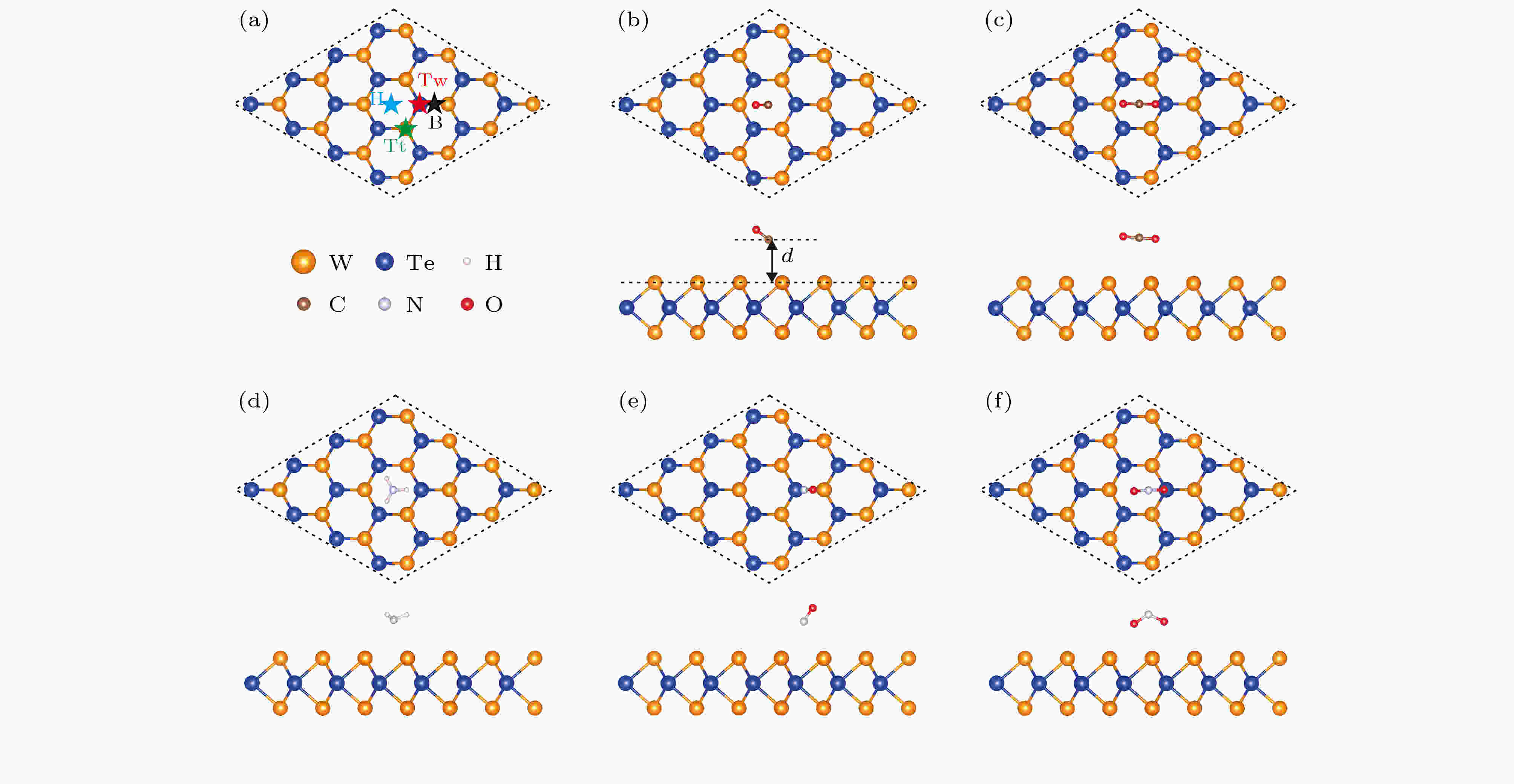
2019, 68 (19): 197101.
doi: 10.7498/aps.68.20190642
Abstract +
Since the discovery of graphene, graphene-based gas sensors have been widely studied, but the inherent zero band gap of graphene limits the response sensitivity of gas sensors. Transition metal dichalcogenides (TMDs) are ideal materials for designing nanoscaled highly-sensitive gas sensors due to their moderate band gaps, large surface-to-volume ratios and high carrier mobilities. Tungsten ditelluride (WTe2), as an important member of TMDs family, has outstanding advantages such as high specific surface area, excellent selectivity, and fast response. The WTe2 has quite a high carrier mobility and thus can provide a great response speed for gas sensor compared with graphene, which motivates us to further explore WTe2 as a promising sensing material. Recent studies have reported that monolayered and multilayered WTe2 films have been successfully synthesized, and the precise control of the number of atomic layers of monolayered WTe2 has been achieved. In this work, by density functional theory calculation, we examine the most stable adsorption configuration, adsorption energy, charge transfer, electrical and magnetic properties for each of the gas molecules (CO, CO2, NH3, NO and NO2) adsorbed on WTe2 monolayer. The results show that all the adsorptions of these gas molecules are physical adsorptions, and the adsorption energy of nitrogen-based gas is smaller than that of carbon-based gas, indicating that WTe2 is more sensitive to the adsorption of N-based gas molecules. The adsorption of NH3 behaves as a charge donor with electron obtained from WTe2 monolayer. The adsorption of CO, CO2, NO, and NO2 are charge acceptors, which accept charges from the WTe2 monolayer. Moreover, compared with the adsorption of CO, CO2 and NH3 gas molecules, the adsorption of NO and NO2 gas molecules introduce impurity states near the Fermi level, which are mainly contributed by the N p orbital and O p orbital. In addition, the adsorption of NO and NO2 induce magnetic moments of 0.99 μB and 0.80 μB, respectively. The results obtained in this work not only conduce to further understanding the charge transfer mechanism of gas molecules adsorbed on WTe2 monolayer, but also indicate the promising prospects of developing WTe2-based ultra-sensitivity gas sensing nanodevices.

2019, 68 (19): 197801.
doi: 10.7498/aps.68.20190978
Abstract +
A symmetrical gold nanorod trimer structure consisting of a short center nanorod and two long nanorods on both sides is proposed. The scattering spectra, electromagnetic field and current density vector distributions across the central cross section of the nanorod trimer are calculated by the finite difference time domain method, and the effects of structural parameters and dielectric environment on Fano resonance characteristics are theoretically investigated in detail. The results show that the Fano resonance can be generated mainly due to the interference between the bonding electric dipole mode in lower energy and the antibonding electric dipole mode or antiphase magnetic dipole mode in higher energy. The Fano dip is blue-shifted with the decrease in the short nanorod length, the size of whole trimer structure with constant displacement, or the refractive index of dielectric medium in the gaps between the central nanorod and two side nanorods; the resonance intensity on both sides of the Fano dip also changes. Meanwhile, the bonding mode on the red side of the Fano dip is gradually dominated by the electric dipole mode of two side nanorods, and the spectral intensity increases, while the antibonding mode on the blue side gradually evolves into the short nanorod-dominated antiphase magnetic dipole mode, and the spectral intensity becomes weaker. The increase in the inter-rod spacing also leads the Fano dip to be blue-shifted, and a similar change in the spectral intensity occurs on both sides of the Fano dip, due to the degeneration of bonding and antibonding modes caused by the decrease of near-field coupling between the short nanorod and two side nanorods, which finally degenerate into the electric dipole modes generated by the short nanorod or the two side nanorods, respectively. In addition, the Fano dip is insensitive to the change of the side nanorod length, but the relative resonance intensity on both sides of the Fano dip also changes. Furthermore, it is found that the spectral contrast ratio of the Fano resonance first increases and then decreases by varying the above-mentioned structural parameters or dielectric environment. These results are expected to be used for guiding the design of Fano controllable nanostructures and also for developing the applications of specific micro-nano photonics.
INTERDISCIPLINARY PHYSICS AND RELATED AREAS OF SCIENCE AND TECHNOLOGY

2019, 68 (19): 198101.
doi: 10.7498/aps.68.20190678
Abstract +
Pure and Au nanoparticles loaded WO3 nanoflowers are synthesized by the hydrothermal method.The structures and morphologies of the as-prepared products are characterized by X-ray diffraction (XRD),scanning electron microswcope (SEM), and transmission electron microscope (TEM). The gas sensing performance of the Au/WO3 sensor to xylene is investigated. The Au content and the operating temperature are first optimized. It is found that WO3 with 0.4 μL Au nanoparticles shows the highest sensitivity at an operating temperature of 250 ℃. Compared with pure WO3, Au(0.4)/WO3 possesses fast response/recovery speed and high target gas selectivity. Its sensitivity to 100 ppm xylene is 29.5. Meanwhile, the practical detection limitation is as low as 0.5 ppm. Finally, the mechanism of Au/WO3 gas sensing is also proposed and discussed. Au nanoparticles loaded WO3 nanoflowers are considered to be a promising sensing material for detecting xylene pollutants.

2019, 68 (19): 198301.
doi: 10.7498/aps.68.20190612
Abstract +
Uniformity of magnetic field is an important parameter of magnetic resonance system. Improving the uniformity of magnetic field is helpful for detecting the magnetic resonance time domain signal and improving the resolution of magnetic resonance frequency domain signal. Based on the idea of continuous current density distribution in an active shimming field, the shimming coil is designed by combining the target field point method with the current function method. That is to say, the relationship between magnetic field distribution and current density is determined by Biot-Savart law. After confining the coil radius and setting the constraint point, the current density distribution on the coil plane is inversely solved according to the target field distribution. Then the current density distribution is discretized by the current function, and the winding position distribution of the uniform field coil is obtained. According to the results of electromagnetic simulation, the first-order and second-order shimming coils are fabricated and applied to the magnetic resonance analyzer. The experimental results show that the shimming coils can effectively improve the magnetic field uniformity of the permanent magnet in nuclear magnetic resonance (NMR) system.

2019, 68 (19): 198501.
doi: 10.7498/aps.68.20190793
Abstract +
In the past, the memristor model and its application research have mainly focused on constructing and analyzing the memristor model and its equivalent circuit model based on the basic concept of memristor, while the research based on commercial memristive devices in the market has been rare. According to the theoretical relationship between meminductor and memristor, a new model of meminductor is constructed based on Knowm memristor, the first commercial memristor chip in the world, combined with the second-generation current conveyor and transconductance operational amplifier. By adjusting the frequency and the amplitude of the input voltage and the transconductance gain of the transconductance operational amplifier, the continuous adjustment of the meminductance can be effectively achieved in the circuit. The LTspice circuit model and hardware experimental circuit of the proposed meminductor are designed. The validity of the new meminductor model and the correctness of the design method are verified by LTspice simulations and circuit experiments.

2019, 68 (19): 198502.
doi: 10.7498/aps.68.20190808
Abstract +
The behavior of transition from short-term memory (STM) to long-term memory (LTM) has been observed and reported in the experimental studies of memristors fabricated by different materials. This kind of memristor in this paper is named STM→LTM memristor. In some of these experimental researches, the learning-experience behavior observed in the " learning-forgetting-relearning” experiment is also reported. When the memristor is restimulated by pulses after forgetting the STM, its memory will quickly return to the highest state that has been reached before the forgetting period, and the memory recovery during the relearning period is obviously faster than the memory formation in the first learning process. In this paper, the behavior of the existing STM→LTM memristor model in the " learning-forgetting-relearning” experiment is further discussed. If wmax, the upper bound of the memory level, is a constant with a value of 1, the STM→LTM memristor model exhibits no learning-experience behavior, and this model shows a faster relearning behavior in the " learning-forgetting-relearning” experiment. The relearning process is faster because the memory forgetting during pulse-to-pulse interval in the relearning process is slower than that in the first learning process. In the STM→LTM memristor model with learning-experience behavior, wmax is redesigned as a state variable in [0,1], and its value will be influenced by the applied voltage. The memory formation in the first learning process is relatively slow because wmax limits the memory formation speed when the pulse is applied. After the forgetting process, the limitation of wmax on the pulse-induced memory formation is less obvious, so the memory of the device increases at a faster speed during the memory recovery of the relearning process. In this case, the forgetting speed still becomes slower after each pulse has been applied. If the pulse-induced wmax increase is so fast that wmax will quickly increase to its upper bound after a few pulses have been applied in the first learning process, and the learning-experience behavior is similar to the faster relearning behavior when wmax = 1. In most of experimental research papers about the STM→LTM memristor, the change of the memristance can be explained by the formation and annihilation of the conductive channel between two electrodes of a memristor. During a certain period of time, the ions (or vacancies), which can be used to form the conductive channel, are only those that are around the conductive channel, which indicates that there should be an upper bound for the size of the conductive channel within this time period. The area in which ions (or vacancies) can be used to form the conductive channel is called the surrounding area of the conductive channel. In the model, wmax can be understood as the size of the conductive channel’s surrounding area, and it describes the upper bound of the width of the conductive channel.

2019, 68 (19): 198503.
doi: 10.7498/aps.68.20190547
Abstract +
Employing the first-principles calculation based on the density functional theory, the geometries, magneto-electronicproperties, and strain effects of the zigzag-edged InSe nanoribbons with the Se-edge saturated by H atoms and In-edge terminated by various non-metallic elements X (X = H, B, N, P, F and Cl) are studied. The calculated formation energy and Forcite annealing simulations show that the H-ZN(7)-X has a stable geometry. For F- and Cl- terminated ribbons, they have a magnetic metallic property similar to that in the case of H termination, and for the N termination the nanoribbon has the strongest magnetic property. However, the B and P terminations cause the magnetic properties at the ribbon edge to completely disappear, particularly when the mechanical strain is applied. The magnetic stability of H-ZN(7)-N is enhanced, and the spin polarization efficiency (SP) at the Fermi level can be effectively modulated in a range from zero to 92%, which means that it is possible to design a mechanical switch for controlling the spin transport at low bias. The strain modulating mechanism is related to the fact that the variation of strain-induced bond length leads the unpaired electrons to be redistributed or disappear. The magnetic properties of N-ZN(7)-N are mainly derived from the p orbitals of In, Se and N atoms, thus it is very important to develop non-transition metal magnetic materials.
GEOPHYSICS, ASTRONOMY, AND ASTROPHYSICS
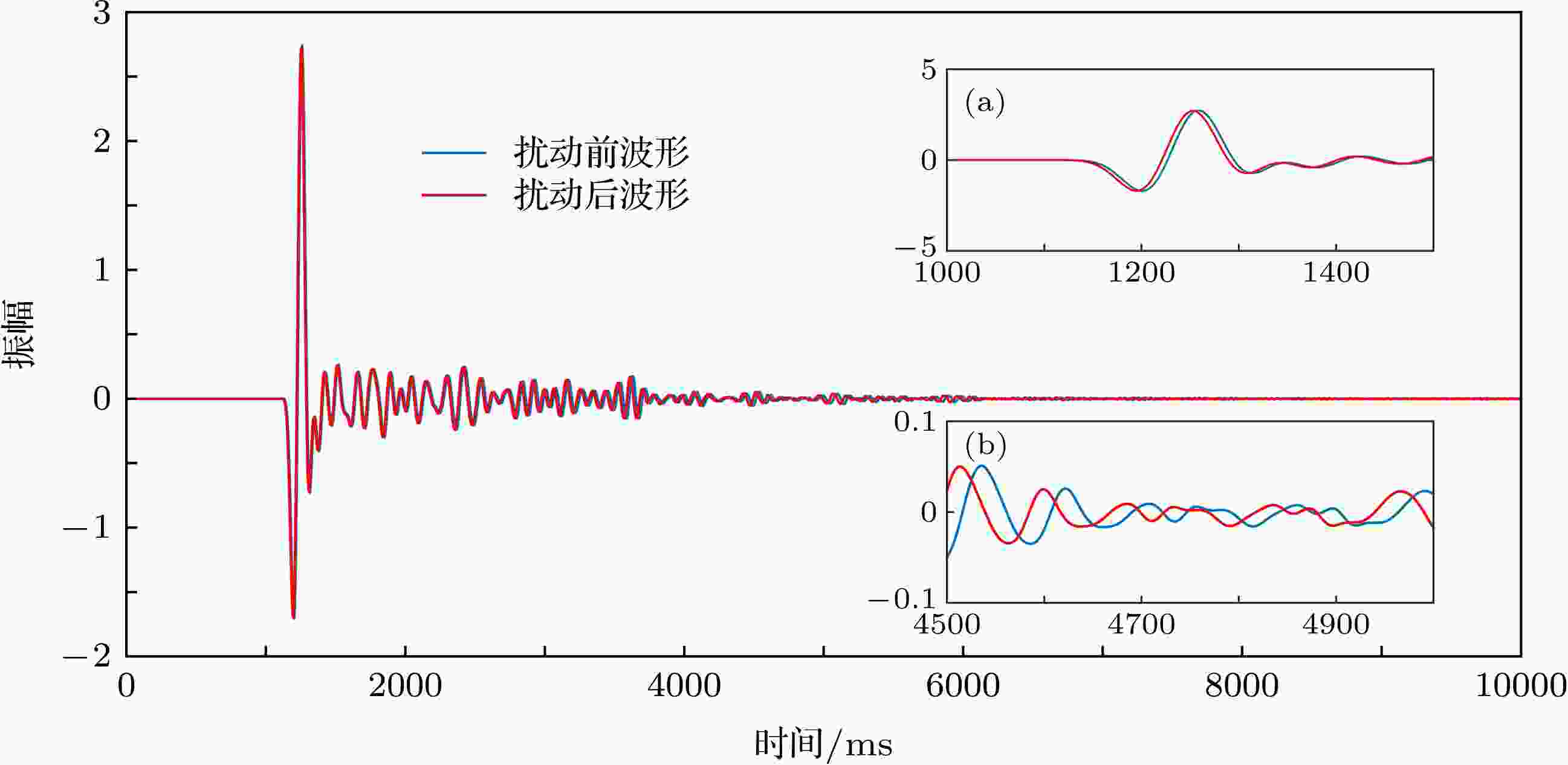
2019, 68 (19): 199101.
doi: 10.7498/aps.68.20190831
Abstract +
The coda wave interferometry is widely used in the fields of geophysics and material science. As an extension of coda wave interferometry, imaging through coda wave interferometry is a technique to obtain the spatial distribution of small velocity perturbations within a scattering medium by using time lapse and sensitivity kernels in the diffusion approximation. However, imaging through coda wave interferometry is essentially an undetermined problem without definite solution, resulting in some difficulties in accurately locating small velocity perturbations within a scattering medium. Meanwhile, compressed sensing has been used in many physical imaging systems in recent years. In this paper, we present an imaging method through coda wave interferometry to solve aforementioned problems by using sparse reconstruction algorithm which is involved in compressed sensing theory. The sparsity of velocity perturbation in its space distribution is taken into account in the proposed method. Firstly, the undetermined equation for inversion imaging is established based on the time-lapse data obtained by coda wave interferometry and the sensitivity kernel matrix in the diffusion approximation. Secondly, the inversion equation is reconstructed by using the sparse transformation within the framework of compressed sensing theory. Finally, the minimization of l1 norm is solved by the compressed sensing reconstruction algorithm, and the imaginary part for the spatial distribution of velocity perturbations is subsequently obtained. This method can accurately capture the spatial locations and ranges of both single velocity perturbation and multiple velocity perturbations in scattering medium with high computational efficiency. The numerical simulations are compared with the results from the existing linear least squares method, demonstrating that the proposed method can avoid the complex parameter determination operation, thus greatly improving the accuracy of inversion images, and also significantly reducing the calculating time.

2019, 68 (19): 199401.
doi: 10.7498/aps.68.20190173
Abstract +
Plasma bubbles in the ionosphere have a significant effect on radio wave communication and navigation. Under the worst condition, it will fail to function the systems relying on the ionosphere. On the other hand, the physical mechanisms of evolution and diurnal variations of the plasma bubbles in the ionosphere are still unclear. Therefore, it is still worthy to simulate the plasma bubbles in the ionosphere for radio wave propagation and science. In this study, the equatorial plasma bubbles induced by one- and two- dimensional disturbance in the ionosphere are simulated, where traveling ionospheric disturbance (TID) is used to produce the two-dimensional disturbance in the ionosphere. The dispersion relationship of gravity wave is used to represent the corresponding wavelength of TID in this study. More importantly, we investigate the effect of recombination rate on the development of plasma bubbles by numerical simulation. The simulation results show that the recombination rate of the plasma in the ionosphere has a significant effect on the development of plasma bubbles. The greater the recombination rate, the more time it takes to produce the plasma bubbles. For one-dimensional disturbance in the ionosphere, there is no significant effect in the structure of plasma bubbles for the recombination rate of the plasma. However, the recombination rate plays a significant effect on the structure of plasma bubbles induced by TID. When the recombination rate is less in numerical simulation, the complex structure including bifurcation, plume-like structures, and pinching of plasma bubbles can occur in the development of bubbles. In contrast, the structure of plasma bubbles is simpler when the recombination rate is greater in simulation. As a result, the recombination rate of the plasma is a significant factor for simulating the plasma bubbles in the ionosphere. The greater recombination rate can result in the slowing down of equatorial plasma bubbles and the simplifying the structure of the bubbles as well. In addition, it is found that not all of plasma bubbles at the bottom of the ionosphere can grow to the top of the ionosphere when many bubbles occur on the bottom side. The direction of the polarization electric field near the bubbles can be changed in the non-linear development of the bubbles. Therefore, only the bubbles where the polarization electric field is always eastward can develop to the topside.
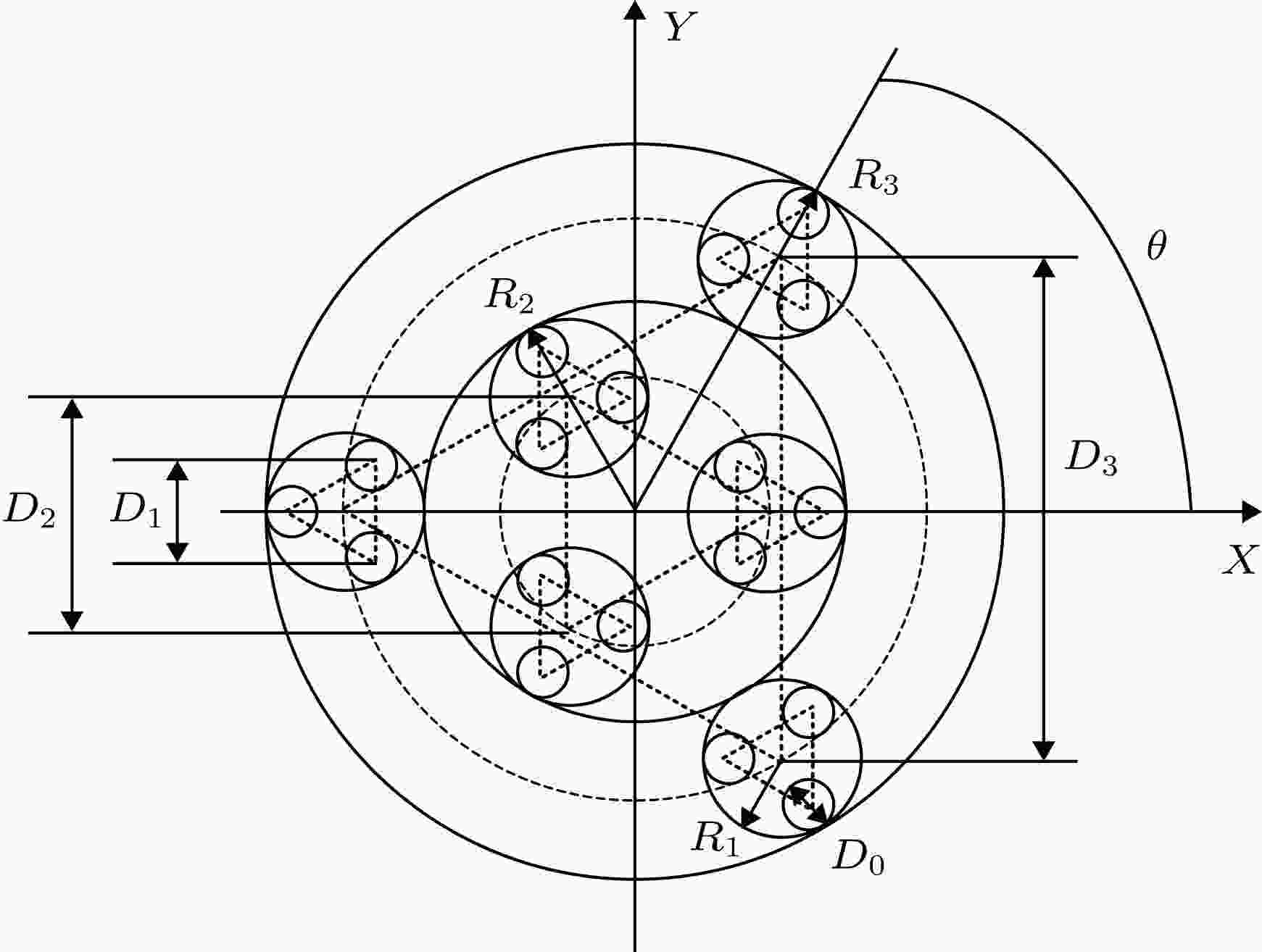
2019, 68 (19): 199501.
doi: 10.7498/aps.68.20190818
Abstract +
The angular resolution of optical system is limited by the ratio of the wavelength to the aperture of the entrance pupil, indicating that the optical system with large aperture has a high spatial resolution. Sparse aperture imaging is one of the effective solutions to the problem that the telescope is bulky, heavy and difficult to manufacture. According to the self-similarity and multi-scale characteristics of fractal configuration, we propose a sparse aperture array and analyze its performance for synthetic aperture imaging system. In the array Golay-3 is used as a structural unit to expand a multi-layered fractal configuration in a self-similar manner. Given the analytical expression of the pupil function which is reduced by dimensionless parameters, we calculate the modulation transfer functions (MTFs), the practical cut-off frequencies and the middle spatial frequency characteristics of the fractal configuration under different fill factors and different outer layer rotational angles. We analyze both the MTF values and the performance parameters of the fractal structure for the cases of N = 3, 9, and 18, respectively. The results show that the decrease of fill factor does not significantly change the MTF curve nor the practical cutoff frequency in a range of fill factor between 0.0952 and 0.2246. The outer layer rotational angle has a periodicity, and the change in the angle has no large influence on the practical cutoff frequency. When the reduced aperture parameter is $ {d_0} = 1$ and the fill factor is 22.46%, the middle spatial frequency of N = 18 array is more stable and the practical cut-off frequency is higher. Using the fractal self-similarity, the aperture of the system can be expanded effectively while maintaining the middle spatial frequency characteristics. The computing results are of scale invariance due to the adoption of the reduced aperture parameter.











